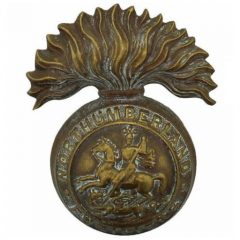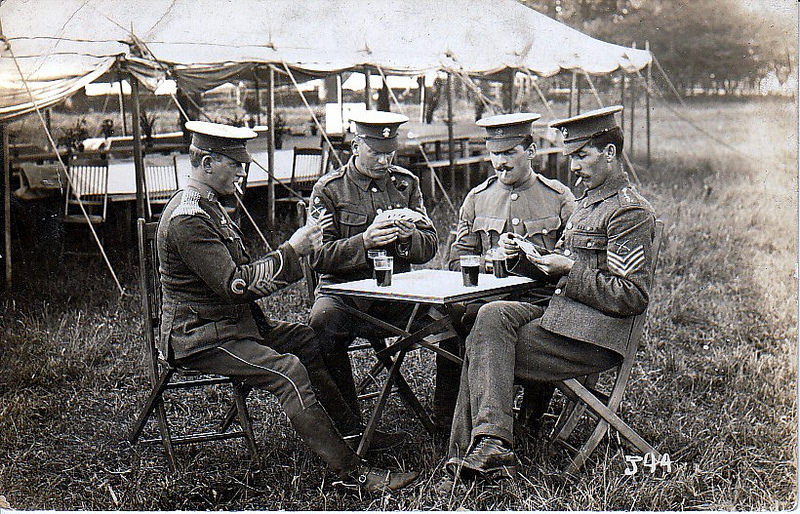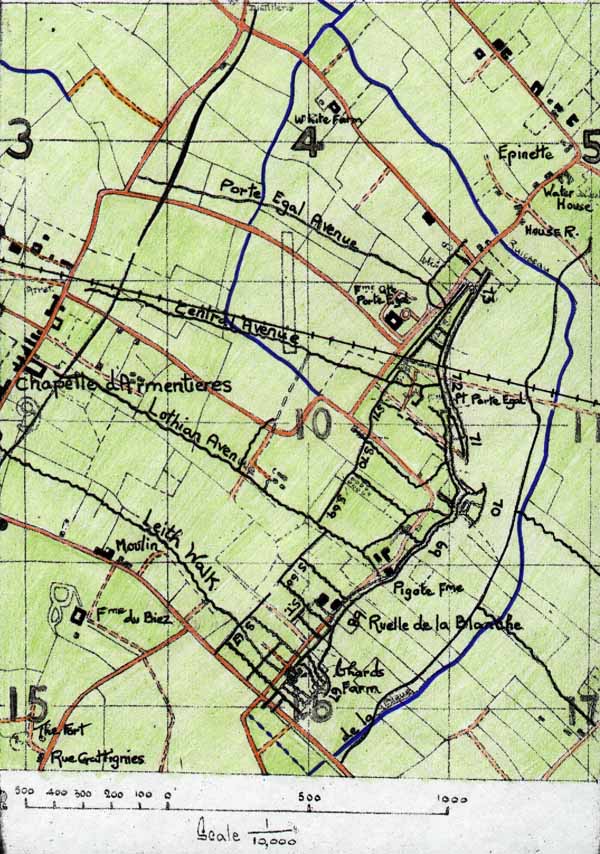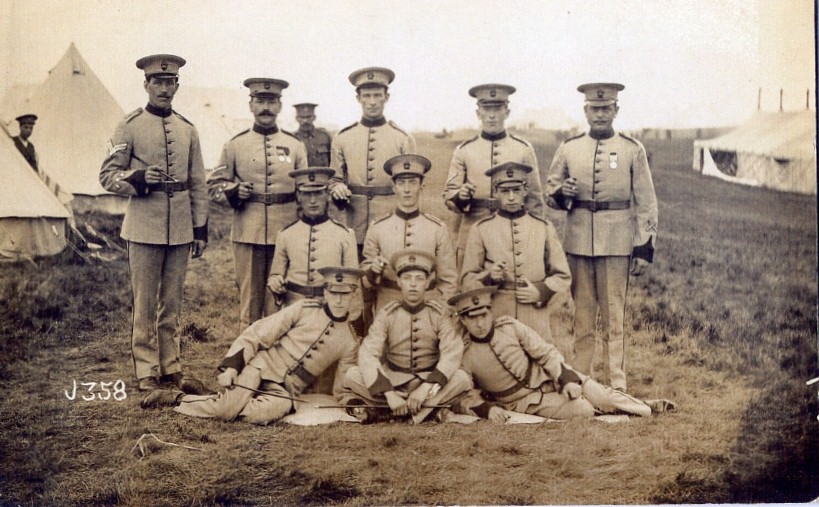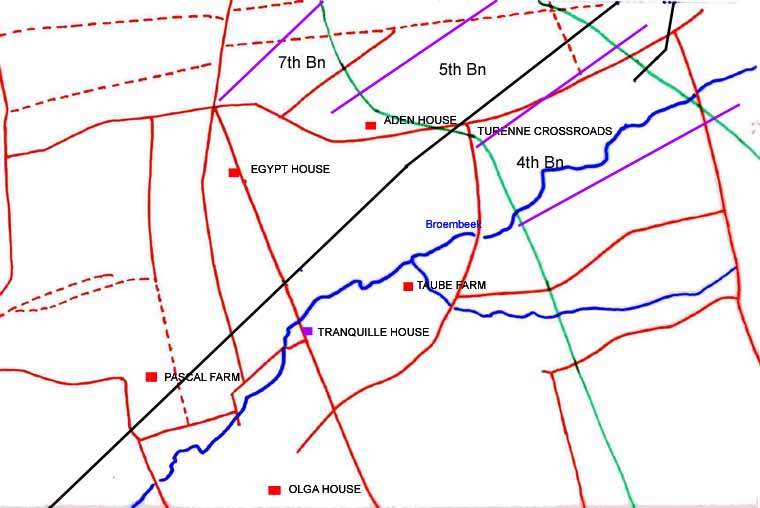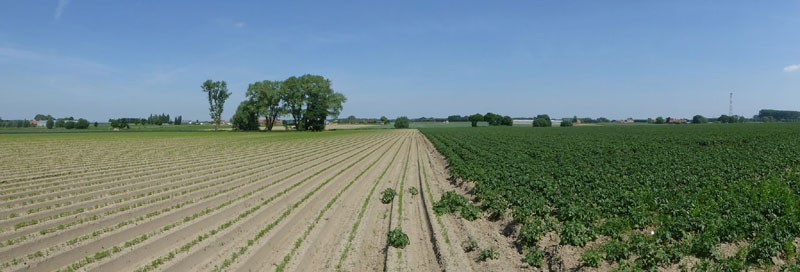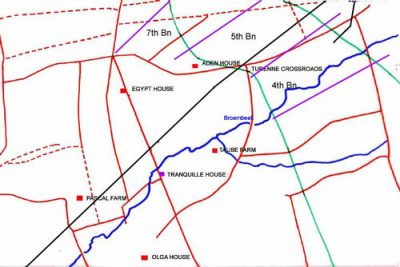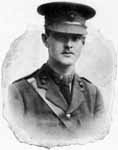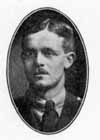Summary of events
When 2nd Lt J.A. Burton actually laid the tape, he realised that there was only sufficient room for an attack frontage of one coy. Therefore, the front line platoon frontage was cut accordingly to one coy, the second coy was positioned to the rear of the right hand coy of the 5th Bn with instructions to wedge between the 4th and 5th Bn Coys at the front once the attack started. The third coy was held in reserve about one hundred yards to the rear of the front line coy (on a two platoon frontage) and the fourth coy under the Bn Cdr was positioned at Taube Farm and Tranquille House .
The Coys assembled in shell holes and dug-in, in the formation described above. A piece of tape was laid to mark the boundary between the 4th and 5th Bn. Hot food was packed in hay and carried up to the coys at the assembly points.
A leap frog system of attack, recently practised in training, was to be employed. The lead platoon was to take the first objective, the second platoon was to pass through to take the second objective, the third platoon the final objective. The fourth under the company commander were to be used for counter attack or consolidation according to the tactical situation.
26th Oct 1917
At 3am heavy rain began to fall again and at 4.05am the 4th Bn reported it was in position for the attack.
At zero hour, 5.40am, the barrage opened up and began to creep forward at a rate of one hundred yards every eight minutes. The fusiliers of the149th Bde rose to their feet to advance behind it, with the 4th & 5th Bn Loyal North Lancashires (57th Divn) on the right flank and the 35th Divn on the left. Had the 'going' been good, the troops who lay close up under the barrage (so close indeed that several casualties were suffered) waiting for the first "lift", would not have had a problem advancing at the rate of the creeping barrage.
'The rain had, however, done its deadly work, for all the gallant fellows could do was to drag themselves along through the thick clinging mud and water at a much slower pace than the barrage, which soon got ahead'. Then form "pill box" and shell hole murderous fire was poured upon them. Many fell dead; some of the wounded fell into the gaping holes of water and were drowned; fortunate were those who escaped, but on went the survivors' (Wyrell. p.244).
The allied barrage consisted entirely of shrapnel and was therefore quite useless against the first objective, which consisted of concrete huts. To make matters worse the rain continued to fall heavily and the condition of mud and water were perfectly appalling.
Bn HQ received a wire from the Bde Major at 8.50am stating that a wounded Forward Observation Officer had reported that the first objective had been taken and the men were advancing well to the second objective. This information proved incorrect because 2nd Lt Wood subsequently returned wounded and reported that casualties were heavy and the attack was held up in front of the Huts. The attack had actually ground to a halt about eighty yards west of the line of huts. The machine gun fire and sniping was so severe that any further advance was quite impossible and reporting the situation back to HQ extremely difficult. Two runners were sent to the front line to try and gather information but they both failed to return.
At 11am, 2nd Lt Burton was sent forward to reconnoitre and he confirmed that the attack was held up about one hundred yards short of the Huts. At 1pm Sgt Thompson returned from the front line and confirmed 2nd Lt Burtons’ report stating that casualties were very heavy. Similar news was brought down later by Capt J.V. Gregory. This information was relayed to Bde HQ by pigeon and signaled by Lucas Lamp. Several messages were sent during the afternoon. Two platoons from the Reserve Company, under the command of 2nd Lts Peddie and Scott, were sent forward at 6pm to consolidate the original line held before the attack.
The Bn was relieved about midnight by the 4th Bn East Yorks and proceeded, via the duckboard track known as Railway Street , to Rose Crossroads camp . The 6th Bn DLI organised straggler posts in likely places to round up men returning from the front line and to guide them to camp.
Roll call revealed the appalling casualties suffered by the 4th Bn. 2nd Lts D.A. Smith, and W. Ruddy had been killed in action with 2nd Lt R.A.A. Simpson later dying of wounds. 2nd Lts G.R. Charlewood, A.W.P. Leary, H.B. Bell, J.R. Ruddock and R. Wood were wounded, and 2nd Lt R.G. Rayner and H. Stobbs were missing. Thirty-six fusiliers had been killed, one hundred and fifty-six wounded and sixty four were still missing. A total of two hundred and fifty six, more than fifty percent of those that had gone into action. The 5th Bn fared even worse with a total of 12 officers and 439 men either killed, wounded or missing. 7th Bn losses amounted to 11 officers and 246 men.
Summary compiled from 149th Bde War Diary, 4th Bn War Diary & History of the 50th Division,
